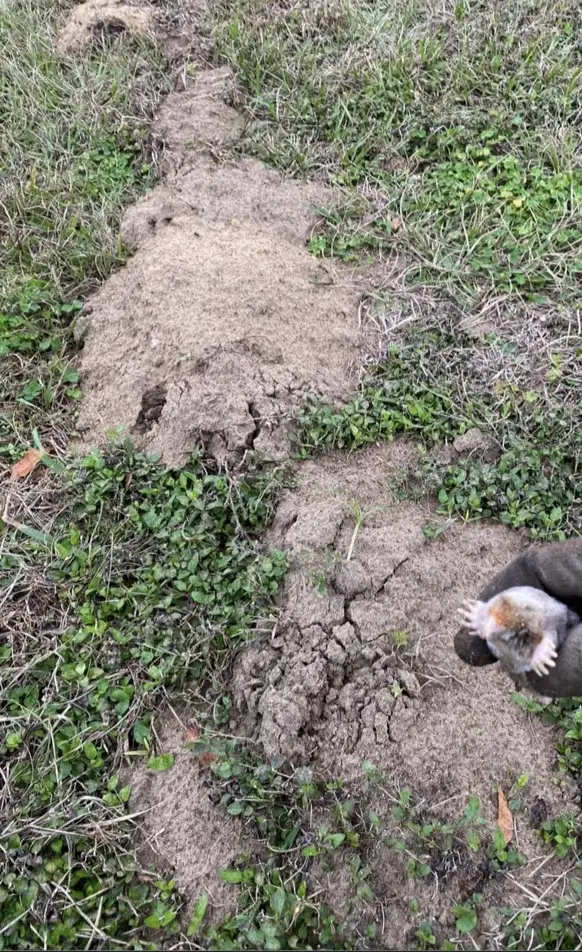Unseen Things: Moles
You put great effort into maintaining and curating your landscaping. If you have a business, you probably care as much about your home yard as the landscaping around your business. You tend to what you see to keep it beautiful, but what you don’t see could wreck your landscape.

Underground Uglies
There are moths, butterflies, and even spiders that the general public will find cuteness in. This does not seem to be the case with the underground diggers chasing earthworms and any other animal it can munch on to feed its voracious metabolism. Whenever people see it the commentary is anything but love and adornment. It probably has to do with the lack of visible eyes on a conical face. Even if it you don’t find it ugly, you will find the damage it does to your landscaping plenty ugly.
Moles create long raised up tunnels as they scoot along on their side pressing the turf up away from the ground seeking to find over half its bodyweight each day in food. The raised tunnels may be straight lines, curvy, or even double back on themselves. Additionally, they have deeper chambers for overwintering, breeding, pup rearing, etc. The creation of these deeper chambers typically result in mounds of chunky dirt kicked out above the ground. The digging and compaction are difficult to return to their original state once dug. Ugly or not, moles wreck a lot of landscapes.

The Landscape Threat
Typically you would think of eating underground worms and insects as a good thing, but the process of collecting them upends what is growing above. In some cases, the tunnels may pull water and nutrients away from key landscape components. In others, the roots will become damaged in the process. Add to this the difficulty of managing edging, rock beds and other landscape additions that moles may displace.
In addition to the threat to plants, mole tunnels create opportunities for other landscape pests to set up strongholds throughout the landscaping.
Other Yard No-See-Ums
Moles are not the only pest that may cause landscape damage and never to rarely be seen. Other common culprits include:

- Pocket Gophers – best known for volcanic shaped mounds
- Meadow Voles – notorious for surface tunnels in the grass (especially under snowpack)
- Rock Voles – infamous for open tunnels into the ground (especially around landscape features and root systems)
- Pine Voles – girdling (if you know, you know)
- Larger Wildlife – this may be chipmunks or squirrels burrowing or burying cache, woodchucks chucking way too much dirt, raccoons grubbing, muskrats setting slippery slides, etc.
It is quite unfortunate that the old wordsmiths decided to make Moles and Voles rhyme. Rhyming names should be reserved for VERY similar animals. Voles are herbivorous and moles are insectivores. If someone would have named Moles as Conediggers and Voles as Grasstrashers, there would be far less wasted effort in applying the wrong treatments.
Can you control what you can’t see?
It may feel unfair fighting a battle against an invisible foe. Rove’s burrowing pest pros are frequently asked whether they can really do anything about them. The best response so far came from Rove’s Associate Certified Entomologist in a meeting with an HOA association. He simply acknowledged the question and motioned for them to follow. Next, he walked over to what he noticed as an active area, give the ground a swift, stunning punch, and pulled out a stunned mole. He handed it to the HOA president, kindly said “that one is for free,” and invited them to put their trust in him. What do you imagine was the HOA response?
Complicated animals
Not all mole control situations are alike. Some can be quite difficult and persistent, but Rove commits to doing what is necessary to put you and your landscape’s well being in the victory seat.
Solving the Autostereogram
If you find it difficult to bring the image into focus, find some tips here. Otherwise, you can just scroll through the original image and then the hidden imagee.


About Rob Greer: Pest Control Expert and Industry Leader
Rob Greer, co-founder of Rove Pest Control, has a deep connection with nature, developed during his upbringing in rural Idaho where he raised horses and cattle. He began his career in pest control in 2001 to support his university studies. After earning a BS in Business Management, Rob, along with Lenny Gray and McKay Bodily, founded Rove Pest Control.
Rob has played a pivotal role in shaping the operational framework of Rove Pest Control, with a focus on personal development for team members, public health awareness, and tailoring services to meet the needs of individuals and communities.
As an Associate Certified Entomologist (ACE) and Subject Matter Expert (SME), Rob has made significant contributions to the pest control industry. He has collaborated on the Minnesota Department of Agriculture’s UMN Extension certification manual and exam development, the National Pesticide Applicator Certification Core Manual for the EPA, and the Quality Pro Customer Service Credential Task Force. His expertise has also been recognized in his testimony for the pest control industry before the Minnesota state legislature as a State Policy Affairs Representative. Currently, Rob serves as the President of the Minnesota Pest Management Association Board. Learn more about Rob Greer.
